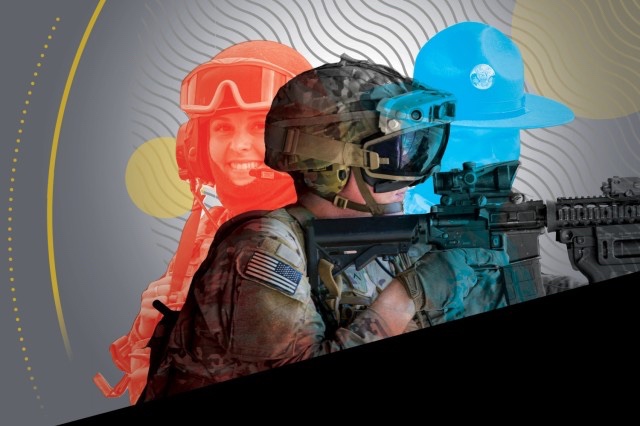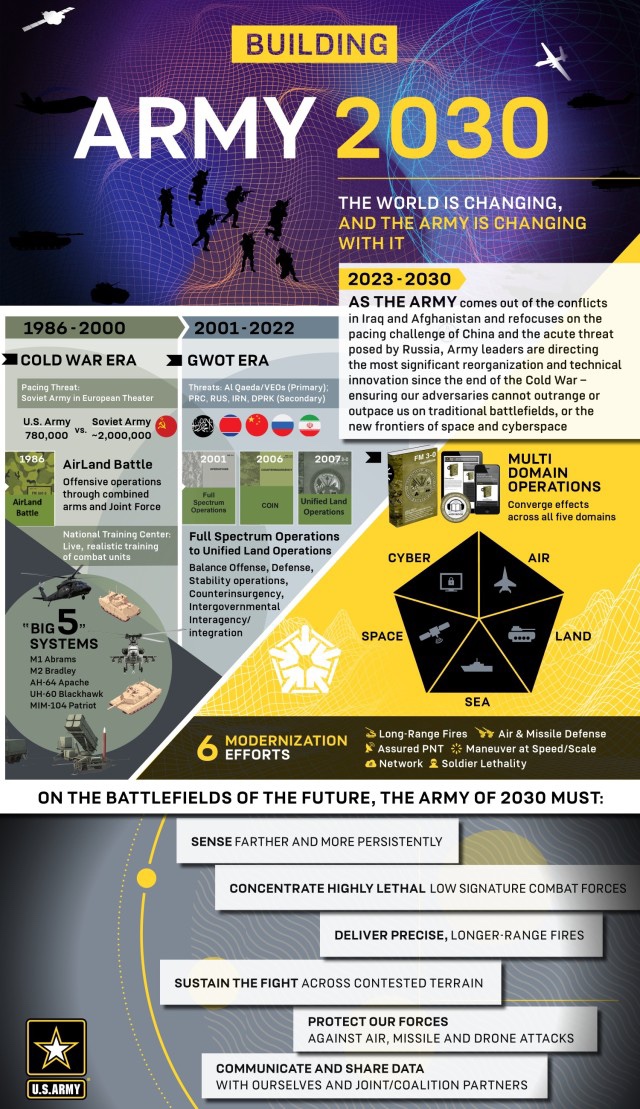
WASHINGTON — As the Army comes out of the conflicts in Iraq and Afghanistan and refocuses on the pacing challenge of China and the acute threat posed by Russia, Army leaders are directing the most significant reorganization and technical innovation since the end of the Cold War — ensuring our adversaries cannot outrange or outpace us on traditional battlefields, or the new frontiers of space and cyberspace. The world is changing, and the Army is changing with it. On the battlefields of the future, the Army of 2030 must:
Acquire sensors to see more, farther and more persistently than our enemies.
Concentrate highly lethal, low-signature combat forces rapidly from dispersed locations to overwhelm adversaries at a place and time of our choosing.
Deliver precise, longer-range fires as part of the Joint Force to strike deep targets and massing enemy forces.
Protect our forces from air, missile and drone attacks.
Be secure from enemy cyber and electronic attacks in order to reliably communicate and share data with ourselves, sister services and coalition partners.
Ensure we can sustain the fight across contested terrain and over time.
To meet the evolving threat, the Army is undergoing a once-in-a-generation transformation to develop the capability to converge effects on land, in the air, sea, space and cyberspace. This transformation includes investment in our people, reorganization of our forces, the development of new equipment, and the adoption of new concepts on how to fight that allow the Army to maintain superiority over any potential adversary.

People: The U.S. Army’s Military Advantage
More than any other area, the U.S. Army relies on cohesive teams that are highly trained, disciplined and fit to fight and win. To maintain a quality force, we must transform the way we recruit, train, educate and prepare America’s sons and daughters for an increasingly complex battlefield. The Army is building a 21st century, data-driven personnel management system to transform how we identify, develop and manage the talent that is the bedrock of our military advantage. Instead of the industrial age system of assigning people to jobs based on a few factors, the Army of 2030 will look at skills, education, experiences and personal attributes to match individuals with positions to which they can best contribute.[1] The Army is also investing in programs and education to improve how leaders identify their own strengths and weaknesses and to allow their organizations and their people to thrive.[2] The Army of 2030 will harness advances in virtual reality and simulations technology to train in more realistic environments at lower cost and with reduced risk to our forces. With the investments we are making, the Army will train Soldiers in simulated environments, where they can interact with and prevail against limitless threats and scenarios, enhancing preparedness from the smallest unit to the largest formation. The Army of 2030 will improve upon our longstanding commitment to the Soldiers who serve, not only with gratitude for their sacrifices, but with investments in their future. In addition to investments in advanced education, comprehensive health and fitness, and development of skills that will benefit them for life, the Army is transforming the way we protect Soldiers, civilians and families from harmful behaviors. The Army is leading the charge to develop prevention efforts for suicide, sexual crimes and extremism while strengthening our support systems to care for those affected.
Transforming How We Organize
To remain the dominant land force on battlefields of 2030, the Army is changing the way it organizes, equips and fights. After two decades of focusing on brigades rotating in and out of Iraq and Afghanistan, the Army is shifting its organizational focus to larger formations that are more capable of working with our sister services, allies and partners around the globe. Theater armies, corps and divisions will gain the personnel, organizations and equipment they need to disrupt and defeat an adversary’s ability to achieve their objectives. These organizational investments are multiplied by leveraging advances in commercial data analytics to improve the speed and accuracy of leader decision-making. Our study and analysis of recent conflicts, exercises, simulations and training indicate that brigade commanders must fully focus on winning the close fight. To allow front-line leaders to concentrate on the close fight, division and corps commanders will have the responsibility and capability to visualize the larger picture. Divisions and corps must be able to employ and allocate the growing array of lethal and non-lethal weapons to attack an enemy across all domains.
Evolving How We Fight
As the Army refocuses from conflict in the Middle East to focus on near-peer challenges, we must adapt to changes in technology and enemy capability and rethink how we deter our adversaries from using force to achieve their objectives. We know that forward positioned ground forces — able to converge effects from land, air, sea, space and cyberspace — complicate our adversaries’ decision-making, disrupt their actions, and assure our allies and partners. Whether in the Pacific or Europe, control of key nodes in the land domain will be required to win in large-scale combat.
The Army of 2030 must equip its forces with new and different capabilities. Many current systems are enduring capabilities developed during the Cold War. To defeat our adversaries on the modern battlefield, the Army is developing newer and more-advanced equipment, and is incorporating cutting-edge technologies to enable us to win on the battlefields of the future.
We are developing a network of connected unmanned and manned sensors that will enable us to see more, farther and more persistently than our enemies.[3]
We will deliver faster, more-survivable fighting vehicles, including unmanned robotic systems able to deliver more firepower.[4]
We will deploy new missiles that are able to travel at hypersonic speeds, increasing the range and ability to avoid traditional air-defense systems.[5]
We will harness the potential of high-energy lasers and microwaves for mobile short-range air-defense systems.[6]
We are innovating, through experiments like Project Convergence, to transform the Army into a data-centric force where commanders at all levels have the information they need to make decisions.
Finally, we are transforming how we sustain the fight by rethinking how the Army provides logistics and sustainment support with lighter and more climate-resilient vehicles and headquarters.[7]
Modernizing for an Uncertain Future
As we transform for the future fight, we are also setting the Army on a sustainable strategic path — one that balances the generational investments we are making to prepare for the future fight with the realities of our fiscal environment. The nation depends on the U.S. Army to respond to a broad range of missions at home and abroad. We must modernize sustainably, maintaining readiness now, while transforming at a pace informed by available resources. This will require hard choices about the pace of modernization and the risk we assume in order to chart a long-term course to integrate new capabilities while maintaining our ability to respond to crises.
Rarely in the Army’s history have we seen changes this significant. As we transform to meet an uncertain future, we must adapt how we recruit and retain talent, how we organize and how we fight to ensure that the Army of 2030 is ready to win when the nation calls. Winning matters.
DOWNLOAD: Army of 2030 Information Paper
DOWNLOAD: Army of 2030 Infographic
By U.S. Army
???????????????
[1] The Integrated Personnel and Pay System – Army (IPPS-A) will become the Army’s total personnel management system. The update pending release in early FY23 will provide the capability for all components of the Army to manage talent and career development.
[2] The Commander Assessment Program (CAP) assesses senior leaders’ ability to lead the Army’s most important organizations. The program was initiated in 2019 and has steadily expanded each year, with an anticipated permanent facility and staff stationed at Fort Knox in FY24. Project Athena provides junior leaders feedback about the skills, capabilities and tendencies they possess as they progress through their careers. The assessment tool is used for officers, warrant officers and noncommissioned officers at each step of their professional military education.
[3] Unmanned Aerial Vehicles have demonstrated in Ukraine the importance of persistent sensors. The Army is investing in systems like the Future Tactical Unmanned Aircraft System (FTUAS), Future Unmanned Aircraft System (FUAS)-Air Launched Effects (ALE), and High Accuracy Detection and Exploitation System (HADES).
[4] The Army will start fielding Armored Multi-Purpose Vehicles (AMPV) in early 2023. The Army recently awarded a contract to field Mobile Protected Firepower (MPF), which will provide infantry units with armored firepower. We are experimenting with Robotic Combat Vehicle technology, with the goal of delivering initial capability by 2030.
[5] The Army is developing four long-range fires systems: Precision Strike Missile (PrSM), Extended Range Cannon (ERCA), Long-Range Hypersonic Weapon (LRHW), and Mid-Range Capability (MRC).
[6] The Army is developing 50-kW high-energy lasers for Maneuver-Short Range Air Defense (M-SHORAD DE) and Indirect Fire Protection Capability (IFPC-DE). The Army Rapid Capabilities and Critical Technologies Office is experimenting with a 300-kW high-energy laser.
[7] The Army is modernizing our watercraft fleet to provide heavy and light versions to enable the execution of contested logistics in the Pacific. The Army is experimenting with hybrid combat vehicles and alternative power for deployed forces to reduce the demand for fuel.

